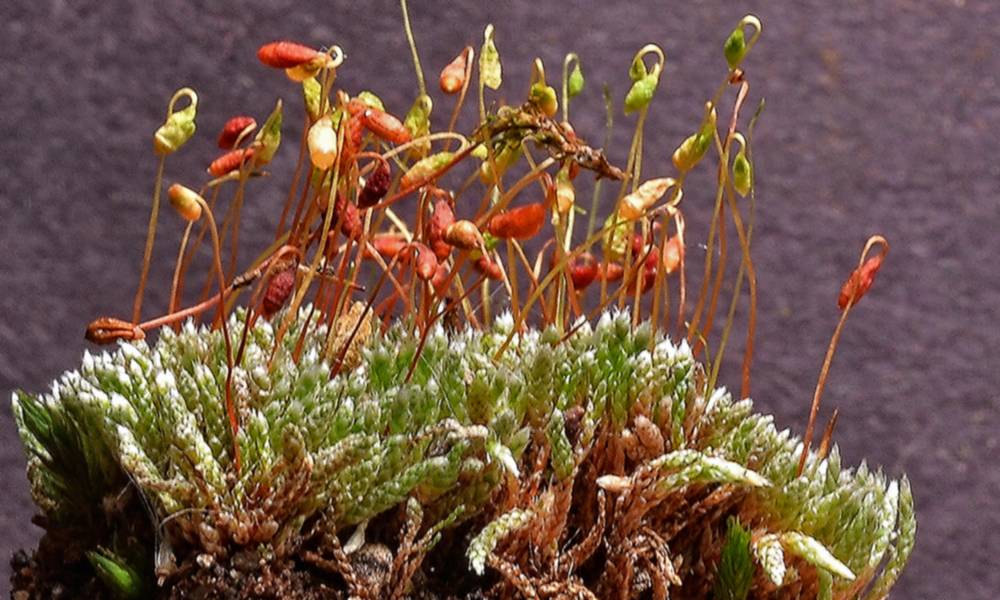
Consortium of Bryophyte Herbaria
- building a Consortium of Bryophytes and Lichens as keystones of cryptobiotic communities -
|
Family: Bryaceae |
Plants: small, gregarious or in dense mats, rarely cushions, white, silver-green, olive, pale green, golden, yellow-green, brown, or yellow-brown. Stems: 0.2–1(–2) cm, weakly to strongly rounded julaceous or short-gemmiform, not or weakly branched; rhizoids few or many, micronemata and macronemata absent from stems or present in clusters proximally. Leaves: with fertile stem leaves imbricate when dry, erect to erect-spreading when moist, ovate-lanceolate to ovate, concave, 0.2–1(–1.5) mm; base not decurrent; margins recurved proximally, plane distally, or often plane throughout, ± entire, 1-stratose, limbidium absent; apex broadly rounded to acute or rarely acuminate; costa not reaching apex or excurrent, apiculus sometimes present if costa not reaching apex, often hyaline, smooth, guide cells usually absent; alar cells not or somewhat differentiated from juxtacostal cells, usually shorter; laminal areolation distinctly heterogeneous; proximal laminal cells quadrate or short-rectangular, 1–2(–3):1; medial and distal cells short-rhomboidal to elongate-hexagonal or rarely vermicular, (1–)3–6(–8):1, walls thin to incrassate, not pitted. : Specialized asexual reproduction by leaf axil bulbils or absent. Sexual: condition dioicous; perigonia and perichaetia terminal, leaves same size as vegetative leaves or usually larger, not forming rosette, inner leaves not much differentiated. Seta: single, somewhat twisted when dry. Capsule: inclined to pendent, ovate or clavate to pyriform, (1–)2–3 mm; hypophysis differentiated or not; operculum weakly convex, short-conic, not rostrate; peristome double; exostome pale yellow or tan, teeth slender lanceolate; endostome separate from exostome or sometimes adherent or absent, basal membrane low to high, segments present, perforate, cilia appendiculate or sometimes absent. Spores: shed singly, not as tetrads, 8–15(–18) µm, finely papillose, pale tan or yellow-tan. Nearly worldwide, temperate to arctic-alpine regions, mountains of subtropical or tropical regions. Species 40 (7 in the flora). Bryum in the strict sense is a genus of small julaceous plants, morphologically similar to Anomobryum. Molecular studies, however, consistently show that the types of the two genera, A. julaceum and B. argenteum, are not closely related. Anomobryum can generally be distinguished from Bryum by its vermicular distal laminal cells and elongate stringlike stems. Bryum species tend to have shorter laminal cells and relatively short, thick, rounded stems. Bryum consists of both silver-white species with hyaline leaf tips, and green to yellow-green species. Many collections of small sterile shoots are difficult to identify. There are at least three undescribed species in the flora area, two of which are discussed under related species. The third is highly distinctive and has been collected recently from southeastern Arizona. Bryum in the broad sense has a reputation for being taxonomically difficult; the genus is highly polyphyletic, and traditionally, many species have been distinguished by minor differences in peristome features. Previous classifications have overemphasized the peristome, placing taxa with strikingly different gametophytes in the same genus. The gametophytes of Bryum vary widely morphologically; this has been used as a basis to reclassify the genus and its relatives (J. R. Spence 2005; Spence and H. P. Ramsay 2005). |
Powered by Symbiota.





